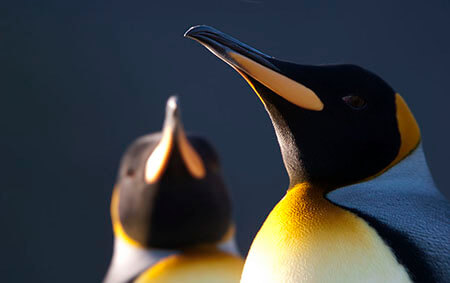 The elegant King Penguin is the second-largest species of penguin in the world, surpassed only by the Emperor Penguin, which occurs further south in the Antarctic.
The elegant King Penguin is the second-largest species of penguin in the world, surpassed only by the Emperor Penguin, which occurs further south in the Antarctic.
The only way to see this bird is to journey to its habitat. Fortunately, many travel outfits, such as Cheesemans' Ecology Safaris, plan trips to the subantarctic, where birders can see the King Penguin as well as other regional specialties, including Gentoo and Macaroni Penguins and other seabirds, such as Wandering and Light-mantled Albatrosses, Snowy Sheathbill, Southern Fulmar, and Antarctic Prion.
King of the Colony
King Penguins inhabit areas with little human activity or settlement, so their numbers are secure at present. However, they are susceptible to the effects of ocean pollution and are affected by changes in ocean circulation caused by climate change.
Sign up for ABC's eNews to learn how you can help protect birds

King Penguins have four layers of feathers that enable them to survive the extreme weather of their sub-Antarctic home. Photo by Ted Cheeseman
"Kings" are highly gregarious, nesting in colonies of up to hundreds of thousands of pairs on coastal plains close to the ocean. (Read about another colony nester, the Inca Tern.) They build no nest, instead laying a single egg that they hold on their feet for the entire incubation period of about 55 days.
The egg is brooded by both parents in turn. Newly hatched chicks are also held on the parents' feet for the first 30 to 40 days, until they develop enough juvenile plumage to regulate their own body temperature.
Deep Diver
King Penguins have one of the longest breeding cycles of birds, fledging at about 14 to 16 months. As a result, King Penguins breed every other year. Chicks overwinter in the breeding colony in densely packed crèches, insulated from the cold by their downy brown juvenile plumage.
Like seabirds such as the Black-footed Albatross and Hawaiian Petrel, King Penguins forage at sea for squid and small fish, especially lanternfish. The penguins dive to depths of 350 to 1,000 feet in pursuit of their prey. They can stay underwater for as long as five minutes.
With four layers of feathers—an oily, waterproof outer layer and three inner layers of down—these birds are well adapted to survive the extreme weather of their sub-Antarctic home.
Donate to support ABC's conservation mission!



















































